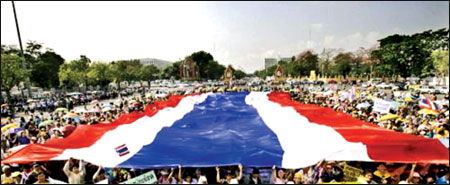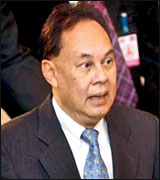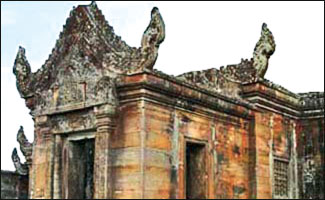Temple tension
P S SURYANARAYANA - Singapore
The ownership of the medieval Temple of Preah Vihear is at the heart
of the border skirmishes.
|

In Bangkok, outside Government House, anti-government protesters
rally under the national flag demanding tough action from the
government on the temple issue |
The sporadic exchanges of fire on the border between Thailand and
Cambodia in early February, in the general vicinity of a Cambodian
“world heritage site”, have escalated dramatically the traditional
tensions between the two neighbours.
The clashes, which tapered off on February 8, lasted several days,
and unofficial accounts on both sides claimed that between five and
eight persons had died. Yet, the Thai and Cambodian authorities sought
to keep the spotlight on the status of the medieval Temple of Preah
Vihear and their respective nationalistic assertions of sovereignty and
territorial integrity.
However, such concerns were not addressed in any direct talks
immediately after fighting flared up on the border. Ironically or
otherwise, the exchange of fire began shortly after Thai Foreign
Minister Kasit Piromya and Cambodia’s Deputy Prime Minister Hor Namhong
had held talks in the normal course in the Cambodian capital Phnom Penh
on February 4. As a result of such a “surprise”, the imbroglio first
turned into a wider regional issue in South-East Asia and then into a
matter of global interest at the United Nations.
The new tensions over the temple, cast a shadow over the internal
cohesion of the Association of Southeast Asian Nations (ASEAN), which
has often prided itself on being a collective force for stability in
this sub-region of East Asia. While Thailand is a founder-member of
ASEAN, Cambodia is one of the later entrants and belongs to the
less-developed category within the 10-member organization. Cambodia does
receive economic aid from Thailand, which emphasized that it had not
suspended its commitments in this regard.
|

Cambodia’s Deputy Prime Minister Hor Namhong |

Thai Foreign Minister Kasit Piromya |
The association had hardly begun to heave a sigh of relief that
Myanmar had finally “elected” a “civilian” head of state on February 4,
when the Thai-Cambodian clashes commenced. The grouping, now headed by
Indonesia, felt confident about shifting its attention from Myanmar to
the Thai-Cambodian crisis, especially when the U.N. Security Council was
preparing to deliberate on the imbroglio.
The basic issue of the temple itself had been eclipsed by the
escalation of external interest on the crisis. The medieval temple was
awarded to Cambodia by the International Court of Justice in 1962. But
the real poser is not whether the site, undoubtedly of interest to both
the Cambodians and the Thais, is of Hindu-Buddhist vintage or of purely
Buddhist origin, although some observers like to cast the standoff in
these terms.
Strikingly more relevant to the hostilities was the fact that just a
few years ago a UN-sponsored organization had declared the temple a
World Heritage Site. Buoyed by that, Cambodia had begun efforts to turn
the site into a major tourist attraction. Of direct relevance to the
hostilities was a “temple management plan” Phnom Penh had submitted to
the United Nations Educational, Scientific and Cultural Organization
(UNESCO) some time ago. As of February 4, Thailand was in the process of
making representations to UNESCO and the World Heritage Committee to
refrain from considering the “temple management plan” pending a
settlement of the border dispute.
The most easily accessible path to the temple passes through
Thailand, which portrays the site as a contentious one pending a
settlement of the border dispute. Thai Prime Minister Abhisit Vejjajiva
has been emphatic on two counts. First, the World Heritage Committee
should not proceed with moves that could render the temple’s final
status as a global site a fait accompli in favour of Cambodia. Implicit
in this is Thailand’s discomfort over the fact that the temple was
already awarded to Cambodia by the World Court.
|
 
The Preah Vihear temple |
Abhisit’s second and more important discourse centres on the current
tensions, which, according to him, can be traced to Cambodia’s “practice
of stationing military forces at the temple”. Such “a practice… must end
entirely”, he said on February 8. Rejecting the Thai version on this
score, the Cambodian Foreign Ministry said the same day that “there have
never been and there will never be Cambodian soldiers at the Temple of
Preah Vihear”. The temple “has always been a place for worship and
tourism”, Cambodia asserted.
On the Thai military’s charge that Cambodia used the temple as a
heavy-arms base to target Thai soldiers operating at a lower altitude,
Cambodia said only policemen armed with light weapons guarded the place
of worship.
Advancing two other collateral arguments, Abhisit said Cambodia’s
perceived militarization of the temple “is a clear violation of the
objective” that influenced a UN-sponsored body to endorse Preah Vihear
as a World Heritage Site. Addressing the Thai National Security Council
in Bangkok, he accused Phnom Penh of “internationalizing the conflict”
over the temple.
Responding to the suggestions from Thailand for talks, a Cambodian
spokesman remarked, on February 9, that “the issue is currently in the
hands of the United Nations Security Council”. As soon as clashes broke
out in early February, Cambodian Prime Minister Hun Sen accused Thailand
of launching “a full-scale armed aggression against Cambodia” and sought
the Security Council’s intervention.
In a letter to it, released on February 7, Hun Sen said: “This fresh
onslaught by Thai armed forces has resulted in more human casualties
(than in any previous clash) and damage to the temple of Preah Vihear as
well as other properties.” In a public speech in Phnom Penh, he
described the situation on the border with Thailand as “a small war” or
at least “a big skirmish”.
To be continued |



